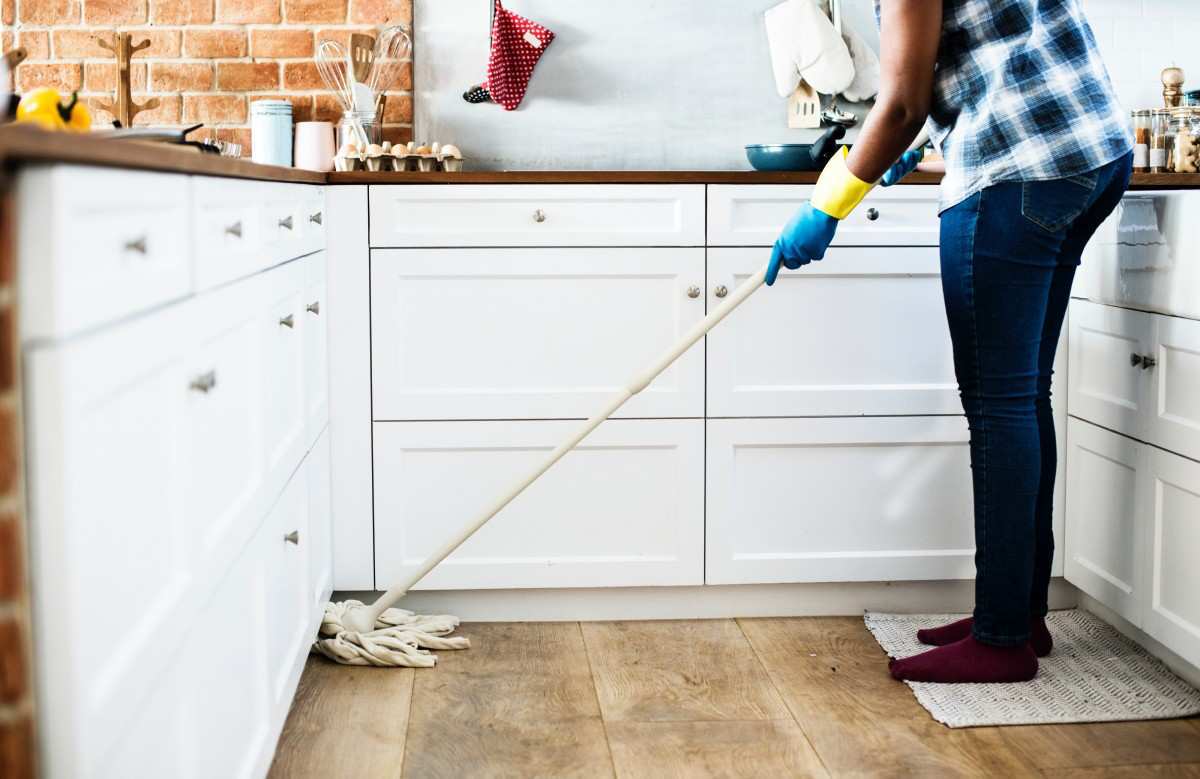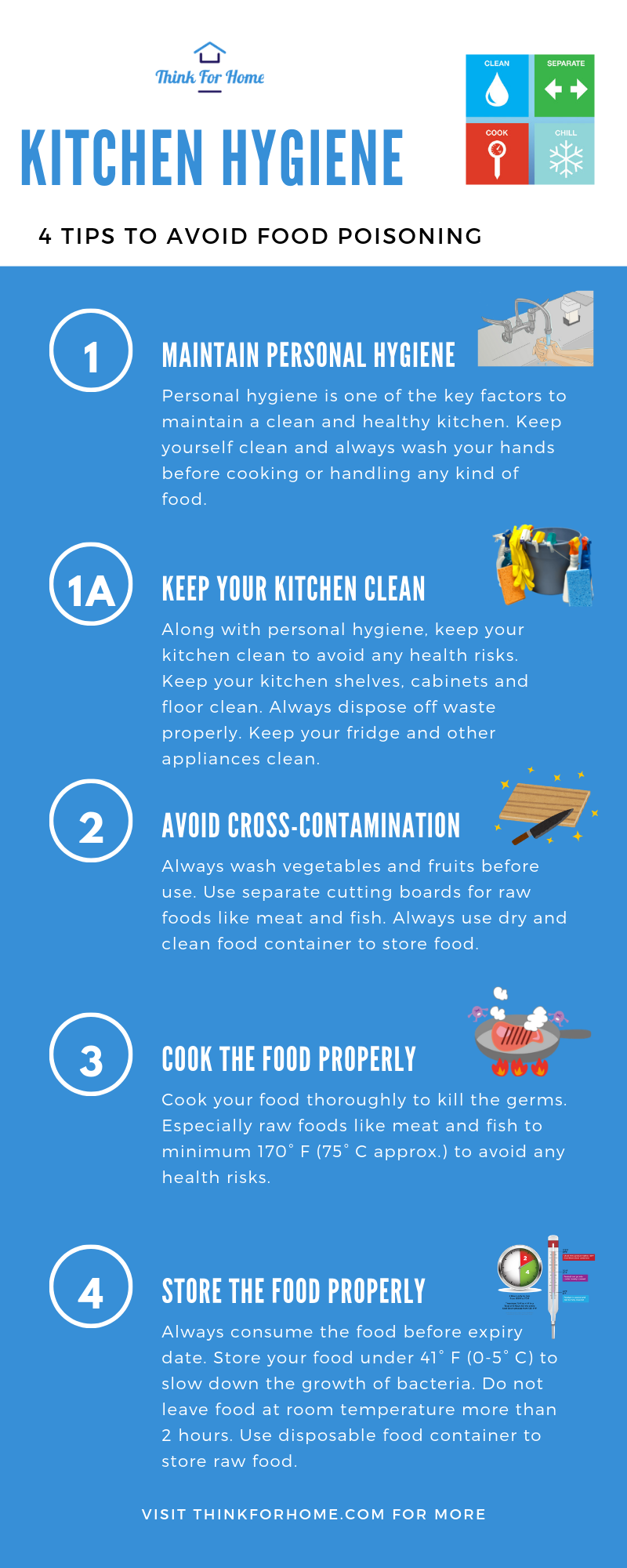In this article, we are going to discuss kitchen safety rules to protect Your Family with Proper Hygiene and Practices.
In our modern lifestyles, the kitchen serves as more than just a room for cooking meals; it’s a central gathering place for families and friends. However, amidst the hustle and bustle of everyday life, it’s easy to overlook the importance of kitchen safety. Ensuring a clean and hygienic kitchen environment is essential for preventing foodborne illnesses and promoting overall well-being. In this comprehensive guide, we’ll delve deeper into essential kitchen safety rules and practices, exploring each aspect in detail to help you maintain a safe and healthy cooking space.

1. Personal Hygiene
Maintaining personal hygiene is the foundation of kitchen safety. Our hands, hair, and clothing can harbor bacteria and other pathogens, which can easily contaminate food if proper hygiene practices are not followed. Here’s an in-depth look at personal hygiene practices for the kitchen.
Short and Clean Fingernails
Keeping fingernails short and clean is crucial for preventing the accumulation of dirt and bacteria. Long nails can harbor pathogens, making it easier for them to transfer to food during meal preparation.
Regular Handwashing
Handwashing is one of the most effective ways to prevent the spread of bacteria in the kitchen. It’s essential to wash your hands thoroughly with soap and water:
– After using the restroom.
– After handling garbage or trash.
– Before and after eating.
– After handling raw meat, poultry, or seafood.
– After touching surfaces that may be contaminated, such as doorknobs or countertops.
Proper handwashing involves scrubbing your hands with soap for at least 20 seconds, making sure to clean between your fingers and under your nails. Rinse your hands thoroughly with clean water and dry them with a clean towel or air dryer.
Oral Hygiene
Maintaining good oral hygiene is also important for kitchen safety. Brush your teeth at least twice a day to reduce the risk of oral bacteria contaminating food during meal preparation.
Tidiness and Hair Restraints
Keeping hair tidy and wearing hairnets or hats while cooking helps prevent hair from falling into food. Loose hair can easily contaminate dishes and pose a health risk to consumers.
Avoiding Jewelry
While cooking, it’s best to avoid wearing jewelry, especially rings. Rings can harbor bacteria and food particles, increasing the risk of contamination. Additionally, jewelry can pose a safety hazard, getting caught in kitchen equipment or utensils.
No Smoking in the Kitchen
Smoking in the kitchen should be strictly prohibited. Tobacco residue can contaminate food and surfaces, posing health risks to those who consume it. Designate a smoking area outside the kitchen to maintain a safe and healthy cooking environment.
2. Kitchen Cleanliness
A clean kitchen is essential for preventing the growth and spread of harmful bacteria and pathogens. Regular cleaning and sanitization of kitchen surfaces, appliances, and utensils are critical for maintaining a hygienic cooking environment. Here’s a detailed look at kitchen cleanliness practices:
Waste Disposal
Proper waste disposal is key to preventing odors and bacterial growth in the kitchen. Dispose of food scraps, packaging, and other waste in designated bins with tight-fitting lids to prevent pests and odors. Empty waste bins regularly, preferably twice a day, to maintain cleanliness and hygiene.
Appliance Cleaning
Kitchen appliances, such as stoves, ovens, microwaves, and refrigerators, should be cleaned regularly to remove food debris and prevent the growth of bacteria. Follow manufacturer instructions for cleaning and maintenance to ensure safe and effective operation of appliances.
Surface Sanitization
Countertops, cutting boards, and other food preparation surfaces should be cleaned and sanitized regularly to prevent cross-contamination. Use hot, soapy water to clean surfaces thoroughly, followed by a sanitizing solution or disinfectant spray. Pay special attention to areas where raw meat, poultry, or seafood may have come into contact with surfaces.
Floor and Drain Maintenance
Kitchen floors should be cleaned regularly to remove spills, crumbs, and other debris that can attract pests and bacteria. Use a mop and floor cleaner to sanitize floors and prevent the growth of harmful microorganisms. Additionally, keep kitchen drains clean and free of clogs to prevent the buildup of organic matter and bacteria.
Storage Organization
Proper organization and storage of food items help prevent cross-contamination and maintain food safety. Store raw meats, poultry, and seafood separately from ready-to-eat foods to prevent the transfer of harmful bacteria. Use sealed containers or storage bags to keep food items fresh and prevent spoilage.
3. Preventing Cross-Contamination
Cross-contamination occurs when harmful bacteria from one food item are transferred to another, posing a risk of foodborne illness. Preventing cross-contamination is essential for ensuring food safety in the kitchen. Here are some strategies to minimize the risk of cross-contamination:
Separate Cutting Boards
Use separate cutting boards for raw meats, poultry, seafood, and fresh produce to prevent cross-contamination. Color-coded cutting boards can help distinguish between different types of foods and reduce the risk of accidental contamination.
Utensil Separation
Similarly, use separate utensils, knives, and kitchen tools for handling raw and cooked foods. Avoid using the same utensils for raw meats and ready-to-eat foods to prevent the spread of harmful bacteria.
Proper Food Handling
Handle food items with care to minimize the risk of cross-contamination. Wash your hands thoroughly before and after handling raw meats, poultry, seafood, or eggs. Use separate utensils and plates for handling raw and cooked foods to prevent the transfer of bacteria.
Cleaning and Sanitization
Clean and sanitize kitchen surfaces, countertops, and utensils regularly to remove bacteria and prevent cross-contamination. Use hot, soapy water to clean surfaces thoroughly, followed by a sanitizing solution or disinfectant spray.
4. Proper Cooking Techniques
Cooking food to the correct temperature is essential for killing harmful bacteria and ensuring food safety. Improperly cooked foods can harbor pathogens that cause foodborne illnesses. Here’s a closer look at proper cooking techniques for different types of foods:
Meat and Poultry
Cook meat and poultry to the recommended internal temperature to ensure that harmful bacteria are destroyed. Use a food thermometer to accurately measure the temperature of cooked meats. The USDA recommends the following safe minimum internal temperatures for various types of meat and poultry:
– Ground meats: 160°F (71°C)
– Poultry (including ground chicken and turkey): 165°F (74°C)
– Beef, pork, veal, and lamb: 145°F (63°C) with a three-minute rest time
Seafood
Cook seafood, such as fish and shellfish, to an internal temperature of 145°F (63°C) to ensure that harmful bacteria are killed. Fish should be opaque and flaky when fully cooked, and shellfish should be opaque and firm.
Eggs
Cook eggs thoroughly until both the whites and yolks are firm to kill any potential bacteria. Avoid consuming raw or undercooked eggs to prevent the risk of Salmonella contamination.
Leftovers
When reheating leftovers, ensure that they are heated to an internal temperature of at least 165°F (74°C) to kill any bacteria that may have multiplied during storage.
5. Proper Food Storage and Handling
Proper storage and handling of food are essential for maintaining food safety and preventing the growth of harmful bacteria. Follow these guidelines to store and handle food safely:
Refrigeration
Refrigerate perishable foods promptly to prevent bacterial growth and spoilage. Keep the refrigerator temperature at 40°F (4°C) or below to slow the growth of bacteria. Store raw meats, poultry, seafood, and eggs in separate containers or sealed bags to prevent cross-contamination.
Freezing
Freeze perishable foods that you don’t plan to use immediately to extend their shelf life and prevent spoilage. Wrap foods tightly in plastic wrap or aluminum foil before placing them in the freezer to prevent freezer burn and maintain quality.
Thawing
Thaw frozen foods safely to prevent the growth of harmful bacteria. Thaw foods in the refrigerator, cold water, or the microwave, never at room temperature. Allow enough time for foods to thaw thoroughly before cooking or reheating.
Food Storage Containers
Use food-safe storage containers to store leftovers and prepared foods. Choose containers that are made of glass, plastic, or stainless steel and have tight-fitting lids to prevent spills and contamination. Avoid reusing containers that previously held raw meats, poultry, or seafood to prevent cross-contamination.
Food Handling Practices
Handle food with care to prevent contamination and ensure food safety. Wash your hands thoroughly before and after handling food, especially raw meats, poultry, seafood, and eggs. Use separate utensils and cutting boards for handling raw and cooked foods to prevent cross-contamination.
Summary
In conclusion, kitchen safety is paramount for protecting yourself and your family from foodborne illnesses and ensuring the enjoyment of delicious and nutritious meals. By following the comprehensive guidelines outlined in this article, you can create a clean, hygienic, and safe cooking environment in your kitchen. From practicing good personal hygiene to maintaining a clean and organized kitchen space, every step plays a crucial role in preventing the spread of harmful bacteria and pathogens. By prioritizing kitchen safety, you can enjoy cooking and dining with confidence, knowing that you’re taking the necessary steps to safeguard your health and well-being.


What’s Happening i am new to this, I stumbled upon this I have found It
absolutely helpful and it has helped me out loads.
I’m hoping to contribute & assist different customers like its
helped me. Good job.
WOW just what I was looking for. Came here by searching for selir69
Asking questions are in fact good thing if you are not understanding anything totally, but this piece
of writing presents pleasant understanding yet.
My blog post; https://www.cucumber7.com/
Hiya very nice web site!! Man .. Beautiful .. Wonderful ..
I will bookmark your website and take the feeds additionally?
I am satisfied to find numerous useful info right here within the submit, we’d like develop more strategies in this regard, thank you for sharing.
. . . . .
Feel free to visit my web blog; https://www.cucumber7.com/